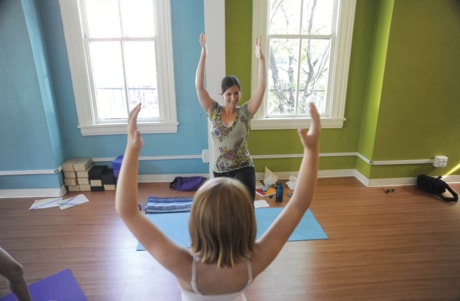“I’m doing it because my mom told me I was going to,” said eight-year-old Iuma Harkness.
“Me, too,” chimed in Samantha Romeo, 9.
Avi Wenger, 57, brought his son, Eli Wenger, 7.
“I’ve been doing yoga for 37 years,” Wenger said. “It’s high time he does it.”
Ashley Comer, Samantha’s mom, had a similar motivation.
“I do yoga and I thought Samantha would enjoy sharing my practice with me,” Comer said.
Iuma, Samantha and Eli were attending a special class of Yoga for Kids at Schoolhouse Yoga in Pittsburgh. The class was taught by Leah Giovengo, who has a master’s degree in counseling psychology and is a certified child and adolescent yoga instructor.
Giovengo is a research clinician at the Western Psychiatric Institute and Clinic. She heads up a research project there on “Yoga for Anxious Children.”
She has been practicing yoga for years, but only has been teaching it for the last two.
“It’s kind of combining my interests,” she said. Yoga “is something I use as a tool to manage stress, so I think it would be a useful practice for kids. Stress isn’t just for adults. Neither is yoga.”
Research on the impact of yoga on children is scarce because the practice is fairly new, but the health benefits for adults are well documented, said William Stixrud, a clinical psychologist in Silver Spring, Md., who recommends yoga to anxious children he sees in his private practice.
“Children’s yoga can increase self-awareness, build self-esteem and strengthen young bodies,” wrote Sean Tearney, who runs several Web-related businesses in Australia geared to improving student performance in school. “It can help coordinate brain functions, balance right and left brain and aid relaxation. Yoga has also been proven to improve concentration, so around exam time a course of children’s yoga sessions could make all the difference.”
“Yoga teaches kids how to use their bodies appropriately, how to breathe appropriately,” Giovengo said. “It’s such a well-rounded program, especially for kids with anxiety.”
The study she’s doing with two other researchers asks children ages six to 16 to try 10 yoga classes. They hope to find if there is a decline in self-reported indicators of stress.
“It’s just a small pilot study,” Giovengo said. “Only 10 kids have been through the program so far, so it’s too early for results. But, she said, “we had some great feedback from parents.”
Uma, Samantha and Eli are not part of the study. They’re all happy, normal children who seemed to enjoy Giovengo’s low-key style as she led them through several yoga poses and taught them a meditation technique.
“The first rule of yoga is don’t do anything that hurts,” Giovengo advised. She asked the children to name their favorite animal, and described poses named after that animal . . . except for Eli’s choice, the elephant.
Most of the poses Giovengo taught were variations of the Warrior pose. “The Warrior is an interesting pose because it teaches kids what they can do, not what they can’t do,” she said.
